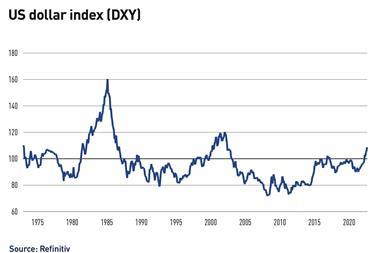The Bank of England (BoE) this morning announced the launch of the additional measures to help ease pressures on the liability-driven investments (LDI) market.
This follows initial temporary emergency action announced by the Bank on 28 September to restore market functioning in long-dated government bonds and reduce risks from contagion to credit conditions for UK households and businesses.
In line with the Bank’s financial stability objective and to avoid dysfunction in core funding markets, the purpose of these operations, it stated, is to enable LDI funds to address risks to their resilience from volatility in the long-dated Gilt market. LDI funds have made substantial progress in doing so over the past week.
As previously announced, the BoE plans to end these operations and cease all bond purchases on Friday 14 October.
This morning, as the final week of operations commences, the Bank announced additional measures to support an orderly end of its purchase scheme: it will increase the size of its daily auctions from today to £10bn from £5bn; it will launch the Temporary Expanded Collateral Repo Facility (TECRF), which will enable banks to help ease liquidity pressures; and it will be ready to support further easing of liquidity pressures facing LDI funds through its regular Indexed Long Term Repo operations each Tuesday.
Beyond the end of this week’s operations, the Bank will continue to work with the UK authorities and regulators to ensure that the LDI industry operates on a more resilient basis.
Steve Hodder, partner at LCP, said: “We have been warning clients that we may be in the ‘eye of the storm’, with further heavy weather possible after the Bank action ends on 14 October.
“These proposals are welcome but do retain one important feature – the ‘cliff edge’ on Friday 14 after which bond buying will stop. If the Bank actually ramps up bond buying lots this week then the cliff edge may be steeper. We do, however, appreciate the Bank’s desire to retain a firm end point, which in itself will act to put further pressure on Government and Treasury to reassure markets of their fiscal responsibility.”
Hodder added that the expanded repo facility is, on the face of it, a “clever mechanism to provide more liquidity to strained investors”, to lessen the need for stressed selling of sterling debt.
“The outstanding question is the extent by which pension schemes (particularly smaller ones) will be able to access this as it’s dependent on how quickly investment managers are able to set up appropriate vehicles,” he said.
James Lynch, fixed income investment manager at Aegon Asset Management, said the Bank was still expected to start unwinding its Gilt holdings in the week of 31 October.
“I think this will depend on the level of yields and how volatile the market is; they will not want to be the cause of any more issues for the Gilt market. Given the tight timescales between ending the current programme on the 14 October and starting the new one on the 31 October, these two weeks will be a tricky period once again,” he said, adding that as this morning the UK budget had been brought forward to 31 October, “Cue the Halloween analogies for the Gilt market.”
Risk of legal action?
Rachael Healey, partner at international law firm RPC, highlighted that trustees of pension funds that had to unwind positions and suffered losses or did not react appropriately to instability in the Gilt market, could find themselves in the “line of fire”.
“Trustees are ultimately responsible for the scheme’s investment decisions. If they fail to review the investment position of a scheme or revisit their deficit reduction plans, then they could find themselves facing legal action,” she said.
In response to the volatility, The Pensions Regulator reaffirmed that trustees and advisers should monitor the resilience of their investments, risk-management practices and funding arrangements.
Healey said that actuaries also need to be aware of the risks that LDI strategies can pose, adding that they are responsible for establishing the investment principles of a pension scheme and should review all investments following market volatility. Actuaries offering fiduciary management services – broadly monitoring investment managers – should also be reviewing their respective positions.
Healey added: “Trustees and actuaries need to ensure they are well-placed to react to market volatility. While not all market moves are foreseeable, trustees and actuaries should have plans in place to react appropriately to market falls and implement solid risk-management practices to limit losses in pension value.”
LDI is intended to manage exposure to inflation and interest rate risk, so that the value of scheme assets fluctuate with the value of scheme liabilities to stabilise the funding level. However, when UK Gilt yields spiked, schemes had to recapitalise their hedges to cover their positions after margin calls.
If a pension scheme does not have enough available cash, they would have to sell other assets, resulting in realised losses from the sale of UK Gilts.
LDI will continue to play a role in pension fund strategies
Last week, LCP conducted research regarding the current situation in the UK LDI markets and found that 90% of more than 400 trustee and company representatives surveyed believe that LDI – perhaps in a modified form – still has a role to play in pension scheme strategies, despite the recent challenges during Gilt market volatility. The survey was undertaken as part of a recent LCP webinar.
This appears to highlight the importance schemes continue to place on LDI strategies helping manage funding level volatility and with that, improved certainty over the level of cash support required from sponsoring businesses at a challenging economic time.
In a second poll of the same group, over half also believed that the BoE will need to extend its support for the Gilt market beyond the current 14 October deadline.
LCP’s Hodder said: “The last couple of weeks has seen much commentary on LDI strategies and how they are being used. We know that headlines can be a bit sensational and let’s face it, LDI is a complex topic. We’re therefore not surprised that there have been a range of interpretations of recent events.”
He added that it was “really interesting to see that our audience, generally well-informed on this issue, overwhelmingly continue to see the value that LDI can bring to successfully securing pension scheme benefits”.
Across the industry there is a clear acknowledgment that LDI strategies will need to be evolved for the current environment, he said, adding that LDI is still an important risk management tool for both trustees and sponsors.
Read the digital edition of IPE’s latest magazine

















